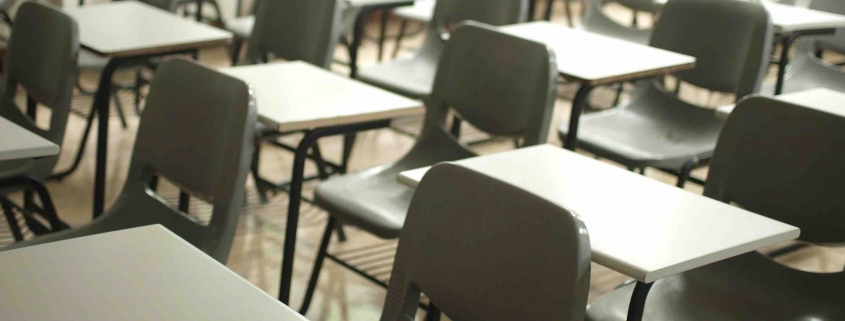A Contemporary Problem of Practice in the Classroom: Linear Classrooms
A Contemporary Problem of Practice in the Classroom: Linear Classrooms
Sarah Graham, English Language Acquisition teacher, Leysin American School
Characteristics of Linear Classrooms
Linear classrooms are commonplace among educational institutions. Linear learning and instruction are derived from the notion that students learn uniformly and dissimilarly. “We remain in a culture that promotes one curriculum for all, one age group and one grade at a time, and one set of tests to determine learning” (Kallick & Zmuda, 2017, p. 1). This classroom environment can only be successful in an idyllic setting, as it assumes that students all share the same personal learning preferences and interests. If education is meant to be a platform to a prosperous experience in life and workforce, then our current educational missions and ideologies need to balance students’ needs and desires with that of the demands of their future. Linear classrooms are malapropos, as they do not foster an enriching and best supportive classroom environment. These classrooms embody a host of characteristics, that more or less facilitate teacher-centralism.
Teacher instruction (direct instruction) is a systematic way of communicating, planning, and content delivery in the classroom (Cagiltay, et al., 2006). Although this method provides a strong structure for concentration on an academic task (Cagiltay, et al., 2006), it assumes that students learn at the same speed and in the same way. The formula for direct instruction is to learn through teacher-directed instruction, stay on task at a predetermined time set by the teacher, and perform or demonstrate learning based on teacher-made assessments (Cagiltay, et al., 2006), which heavily reduces students’ capacity for being the captains of their own learning.
Again, linear classrooms assume homogenous learning styles. All students are given the same style of instruction and expected to complete the same demonstration-of-learning activity. These teacher-designed activities assume sole responsibility that sufficient learning will take place, and then be measured by the teacher-selected/teacher-designed assessment. A homogeneous learning environment ignores individual differences of skill, ability, and interests.
In addition, linear classrooms, by design, presume a homogenous pace of learning. Based on the aforementioned formula, students receive direct instruction and perform the academic activity, whilst remaining on task. Teachers have a predetermined time frame of when students will master the skill/content objective. Within this realm, teachers have the full responsibility of creating academic content/skill objectives, designing the way in which students learn (teacher-planned learning initiatives), providing feedback to reinforce learning, and administering assessments; all with the assumption that students will need the same amount of time to complete each step.
Pitfalls of Linear Classrooms
We need students to become metacognitively familiar with what they want to accomplish and who they want to become (Kallick & Zmuda, 2017). With linear classrooms, opportunities for self-exploration, growth of social capital, and development of voice are limited. “Students from even the most privileged schools may suppress their aspirations- their passions and intense interests- because their deepest desires are held captive to the practicality of what others call success” (Kallick & Zmuda, 2017, p. 2). Standardized learning and linear classrooms prohibit and incapacitate the opportunities to enrich and deepen learning experiences. Although our economical world is shifting globally from industrialism to personalization, which is revolutionizing music, medicine, politics, publishing, etc., our schools remain stagnant and immobilized in tradition of teaching to a one-size-fits-all standard through our linear classrooms.
Linear classrooms create an environment of automatic learning. In other words, it creates habits of valuing rote recall and memorization. Imagine driving a car, you engage your long-term memory automatically to turn on the engine, shift gears, accelerate, merge, and pass other drivers. Relying solely on automatic learning doesn’t prepare for drivers in unpredictable disruptions, such as sleet or the engine overheating (Kallick & Zmuda, 2017). Automatic learning can be helpful in acquiring academic knowledge, but it doesn’t aid in developing a skill set beyond standardized testing. In other words, it doesn’t help students to pursue strategic abilities and “expand their resourcefulness and capacity for engaging with and solving challenging problems” (Kallick & Zmuda, 2017, p. 9). Heretofore, teachers in linear classrooms utilize discipline-specific learning goals, which are “woefully insufficient if we want students to thrive in a modern world (Kallick & Zmuda, 2017, p. 13).”
The prevalence of linear classrooms perpetuates common classroom issues, such as low motivation, fewer opportunities for social-emotional and metacognitive development, and fewer opportunities of content-mastery and multiple displays of learning. When teachers set the learning target, the time frame, the tasks, and assessments, students will have little to no ownership of their learning and abilities development. In shifting responsibilities to students, the changes will be positively irrevocable, as they develop academic and dispositional competencies. Learning should be teacher-led and student directed, which is oppositional to that of linear classrooms. The teacher-determined curriculum can encompass broader learning goals that extend beyond the academic objectives to incorporate cross-disciplinary and dispositional goals, in which student-teacher collaboration will empower students with a voice in their own learning (Kallick & Zmuda, 2017).
Linear classrooms are not self-paced, personalized, differentiated, or individualized. It is un-customizable to student’s interest and style of learning, and leaves the potential for negative stigma for “branded” special education students that are unable to match the pacing set by the teacher. A flexible and personalized classroom can allow for student equality even amongst our higher-achieving students. It can help our students to “pursue aspirations, investigate problems, design solutions, chase curiosities, create performances,” (Kallick & Zmuda, 2017, p. 2-3) and most importantly expose students to meaningful problems and challenges, which will ultimately help them to develop skills such as striving for accuracy, taking responsible risks, and developing persistence.
The roles of the teacher and student have been widely researched, and thus more questions have been asked than answered. What has become undoubtably clear is that the role of the teacher needs to be radically changed from a linear, teacher-centric role to a learning mediator and coach (Wismath, 2013). Teachers shouldn’t be the tap that turns on or off the nozzle that determines a student’s learning capacity; instead we should have a meta-role as the mirror that reflects students’ action and decision-making in their pursuit of knowledge and ability. In evaluating the characteristics and pitfalls of linear classrooms, it is clear the glass ceiling created by a linear mentality prohibits and demotes necessary and valuable non-academic skill sets. Stepping outside the linear classroom into a multi-directional (non-linear) learning environment is of great interest and remains non-negotiable.
References
Cagiltay, N. E., Yildirim, S., & Aksu, M. (2006). Students’ Preferences on Web-Based Instruction: linear or non-linear. Journal of Educational Technology & Society, 9(3), 122–136. https://www.jstor.org/stable/pdf/jeductechsoci.9.3.122.pdf
Kallick, B., & Zmuda, A. (2017). Students at the Center: Personalized Learning with Habits of Mind (1st ed.). ASCD.
Wismath, S. L. (2013). Shifting the Teacher-Learner Paradigm: Teaching for the 21stCentury. College Teaching, 61(3), 88–89. https://doi.org/10.1080/87567555.2012.752338
What do you think about the points raised in this article? We’d love to have your thoughts below.
ABOUT THE AUTHOR

Sarah Graham is an English Language Acquisition and psychology teacher for 9th and 10th grade at Leysin American School in Switzerland. She has worked as a teacher for 7 years and in the international market for 5 years. She is currently pursuing an Ed.D in Educational Practices and Leadership with an emphasis on Teacher Education. Sarah’s aim is for students to gain skills beyond discipline-specific goals and to develop dispositional competencies, such as listening with understanding and empathy, persistence, taking responsible risks, flexibility, etc. She believes that if we want our students to be successful in a quickly evolving workforce and rapidly changing modern world, our education needs to reflect that in a holistic manner.





Definitely insightful! I have wondered about a similar paradigm in education as well. As a relatively new teacher, a prescribed curriculum that a teacher can work from is both helpful but I can see how it could be limiting, especially after reading this article. I’m wondering where to delineate between prescribed curriculum and one that lets the student discover their own path of learning. Is there an easy way to implement non-linear teaching practices?